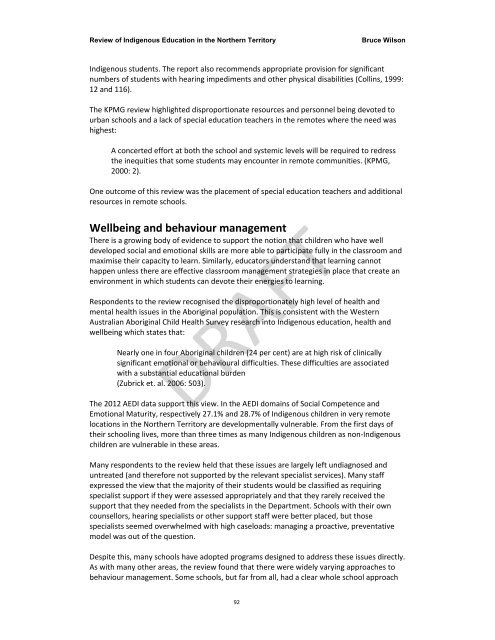Indigenous-Education-Review_DRAFT
Indigenous-Education-Review_DRAFT
Indigenous-Education-Review_DRAFT
You also want an ePaper? Increase the reach of your titles
YUMPU automatically turns print PDFs into web optimized ePapers that Google loves.
<strong>Review</strong> of <strong>Indigenous</strong> <strong>Education</strong> in the Northern Territory<br />
Bruce Wilson<br />
<strong>Indigenous</strong> students. The report also recommends appropriate provision for significant<br />
numbers of students with hearing impediments and other physical disabilities (Collins, 1999:<br />
12 and 116).<br />
The KPMG review highlighted disproportionate resources and personnel being devoted to<br />
urban schools and a lack of special education teachers in the remotes where the need was<br />
highest:<br />
A concerted effort at both the school and systemic levels will be required to redress<br />
the inequities that some students may encounter in remote communities. (KPMG,<br />
2000: 2).<br />
One outcome of this review was the placement of special education teachers and additional<br />
resources in remote schools.<br />
Wellbeing and behaviour management<br />
There is a growing body of evidence to support the notion that children who have well<br />
developed social and emotional skills are more able to participate fully in the classroom and<br />
maximise their capacity to learn. Similarly, educators understand that learning cannot<br />
happen unless there are effective classroom management strategies in place that create an<br />
environment in which students can devote their energies to learning.<br />
Respondents to the review recognised the disproportionately high level of health and<br />
mental health issues in the Aboriginal population. This is consistent with the Western<br />
Australian Aboriginal Child Health Survey research into <strong>Indigenous</strong> education, health and<br />
wellbeing which states that:<br />
Nearly one in four Aboriginal children (24 per cent) are at high risk of clinically<br />
significant emotional or behavioural difficulties. These difficulties are associated<br />
with a substantial educational burden<br />
(Zubrick et. al. 2006: 503).<br />
<strong>DRAFT</strong><br />
The 2012 AEDI data support this view. In the AEDI domains of Social Competence and<br />
Emotional Maturity, respectively 27.1% and 28.7% of <strong>Indigenous</strong> children in very remote<br />
locations in the Northern Territory are developmentally vulnerable. From the first days of<br />
their schooling lives, more than three times as many <strong>Indigenous</strong> children as non‐<strong>Indigenous</strong><br />
children are vulnerable in these areas.<br />
Many respondents to the review held that these issues are largely left undiagnosed and<br />
untreated (and therefore not supported by the relevant specialist services). Many staff<br />
expressed the view that the majority of their students would be classified as requiring<br />
specialist support if they were assessed appropriately and that they rarely received the<br />
support that they needed from the specialists in the Department. Schools with their own<br />
counsellors, hearing specialists or other support staff were better placed, but those<br />
specialists seemed overwhelmed with high caseloads: managing a proactive, preventative<br />
model was out of the question.<br />
Despite this, many schools have adopted programs designed to address these issues directly.<br />
As with many other areas, the review found that there were widely varying approaches to<br />
behaviour management. Some schools, but far from all, had a clear whole school approach<br />
92


